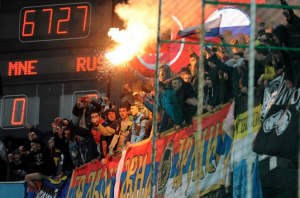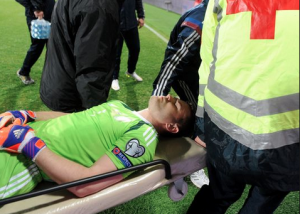On Friday, the Montenegro vs. Russia Euro qualifier match was cut short after two incidents involving home fans throwing objects onto the pitch. The first of the two incidents occurred only 25 seconds after the match began, and delayed the game for over half an hour as a fan hit Russian goalie Igor Akinfeev in the head with a flare. The goalie had to be rushed to the hospital and treated for burns inflicted by the flare, and was said to be “a lucky man not to have suffered worse.” The game was let on, and after halftime was called to an end in the 67th minute after another player was hit by a cigarette lighter that was thrown from the crowd.
In reaction to the chaos that took place, UEFA opened disciplinary proceedings against the soccer federation of Montenegro early Monday morning. However, they have to wait for more concrete details and thus cannot come to any conclusions before this upcoming weekend. On the Russian side, the soccer federation has lodged a complaint that may result in its team being awarded a 3-0 win and three points in Group G. The most notable reaction came from the Montenegrins, however. To start, Coach Branko Brnovic voiced his opinions, stating “my players are depressed…we will be playing without fans for who knows how long after this.” The administration continued to comment about the incidents that took place, with general secretary Momir Djurdjevac even stating that, “we are left with the impression of barbarians. It seems we don’t deserve a nation, a team or berth in a major tournament.”
Looking back on all this, I think that these events that occurred on Friday portray a more significant problem that the “sport” of soccer currently faces. Although it is arguably the most nationally-tied sport in the world, where fans seem to be most proud of their nations to play and win, is there a point where FIFA and other leagues should consider drawing a line? Soccer fans and crowds have become notoriously known for incidents like those of Friday’s for as long as large crowds have been allowed at games. It is no longer a surprise when such outbreaks occur, but why is that? Why don’t other sporting events ignite such barbaric actions from their fans, or if they do why do they occur in such less frequency? To me, it seems like a player being physically injured from such actions should raise alarms to administrators about potentially cracking down on all fans. I have never been to a professional soccer match, but it seems like nearly anything can be brought in by fans. At other sporting events, fans are patted down for anything more than a sandwich before entering the stadiums. After Friday’s tragedies, is it fair to say that soccer commissioners should look into changing protocol? Should fans be checked more intensely, or does this fervent nature contribute so much to the sport that nothing should be done?
All of these questions will have to be answered in due time. We cannot predict what administrators will decide after the events that occurred on Friday, but there is one thing that we can all be sure of: Montenegrin soccer will now be looked at in a different light, one that most definitely is associated with that of savagery, negativity, and ferocity.



It was interesting to read this post, especially in light of recent controversial events in soccer. People around the world paid attention when a video of Chelsea fans forcing a black man off of a train and openly screaming racist chants surfaced on internet. Although it did not receive as much coverage, people also read stories of Nazi and anti-Semitic chants in a Dutch league game. Your post only seems more relevant when considering these other issues that have plagued the sport in diverse leagues around the world. It really does make us wonder what the role of the fan has become.
This incident truly highlights UEFA’s failure to have any sort of expedient, official protocol in place to respond to these types of fan violence. Given that these types of incidents are (sadly) happening more and more often, as evidenced by other incidents of fan violence in Italy and really all throughout Europe, UEFA needs to create a quick action plan that deals with the situation safely and effectively. Much of the criticism of the event has come from the fact that the game should have stopped after the Russian goalie was first injured and carried off the field. However, the referee believed the game should go on, and it’s just ridiculous that a second player was hurt after the situation at the stadium was already spiraling out of control.
Montenegro is now in disciplinary proceedings due to the fact that it held “a match that did not get played in full.” However, the current protocol is lengthy and drawn out, as UEFA waits on official statements from the referee and match delegates, which is then followed by ethics committee meetings to determine the appropriate punishment. A new policy needs to be created to deal with fan violence and the corresponding punishment depending on the event.
This is an interesting piece. However a question should be asked whether it is fair to punish a whole fan base as well as a whole national team because of one or two rogue individuals. the national team will have to play without fans while thousands of fans will not be allowed to cheer their favorite team on the pitch. I think an effort should be made to be able to easily identify such individuals and punish the specific hooligans instead of punish a whole nation for something they had no control over and didn’t were not necessarily in support of.
Thanks for the post, Spencer. Its disturbing to think that fans’ support for their teams lead them to harming the opposing teams’ players. I can not even fathom what the fan was thinking when he physically harmed the Russian goalie – rage, anger? What I’m also curious about, but admittedly ignorant about, is current affairs in Montenegro and relations between Russia and Southern European countries. While crowds of fans are rowdy in general, something has to trigger them to act in the extreme – domestic politics, national politics – anything. The extreme rage of fans, particularly football fans, is often a reaction to their nations’ political, economic and/or social climate and stability.
I can’t believe that fan mentality can take over an entire stadium like that. I think it’s definitely time for commissioners to draw the line and take action regarding these fan issues. We’ve talked about in class how in many European games the opposing side’s fan section is surrounded by a giant net to stop objects that are thrown from landing on top of them. I think it could potentially be time for a similar net to separate the field from the fans if these fan actions do not stop. It’s a shame, however, that we would have to resort to having a net separate those on the field from those on the pitch as part of the appeal of soccer comes from the collaboration of fans with players. The idea of having a net surround a field is not entirely foreign to the world of sports as there is always a net behind the goal posts in football to stop the ball from sailing into the crowd. But it is also for this reason that I prefer to sit behind the benches instead of behind the endzone because of both the unobstructed view and seeming connection to the field. Player safety obviously trumps all other aspects of the game, especially fan experience, but it’s a shame that these goals are in opposition to one another in this situation.